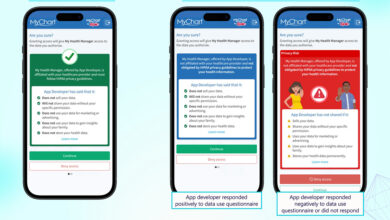A physician telehealth expert talks disparities, advocacy, behavioral health and at-home labs


For Dr. Kate Sowerwine, chief medical officer at Recuro Health, a telemedicine technology and services company, her journey into medicine was deeply influenced by the challenges her mother faced while managing her diabetes. Witnessing her struggle to navigate a complex and often overwhelming healthcare system left a lasting impression on Sowerwine.
Her mother encountered multiple barriers – from understanding her condition to accessing necessary medications – and often found herself without the support she needed. There were times when she had to go without medication simply because there was no one to help her navigate the healthcare system.
This experience sparked a passion within Sowerwine to become the kind of healthcare provider who could bridge these gaps and offer the guidance and care her mother, and so many others, desperately needed.
As she progressed in her medical career, Sowerwine found tremendous fulfillment in caring for patients, helping them understand their health, and guiding them through the steps they needed to take to improve their overall wellbeing.
Her work in her in-person specialty clinic has been incredibly rewarding, but she soon recognized the potential to expand her impact through telemedicine. By growing this aspect of her practice, she has been able to stay connected with patients in a way that transcends geographical boundaries, ensuring they receive the continuity of care they need.
In the time she’s been with Recuro Health, the company has transformed from focusing on urgent care telemedicine to offering a full spectrum of services, including urgent care, behavioral health, virtual primary care, and at-home labs and diagnostic ordering.
Healthcare IT News sat down with Sowerwine to discuss how telehealth is helping combat healthcare disparities, how it is aiding healthcare advocacy, how it is boosting behavioral healthcare, and how at-home labs work and are related to telemedicine.
Q. How is telehealth helping combat healthcare disparities today?
A. Telehealth is a powerful tool in addressing healthcare disparities, especially for patients who face challenges such as limited transportation or resources.
African Americans, in particular, encounter significant health disparities, including higher rates of heart disease, high blood pressure, diabetes and stroke compared with their Caucasian counterparts. Social factors such as unemployment, poverty and limited access to medical care contribute to these disparities.
For example, African Americans are 30% more likely to die from heart disease and are less likely to have their blood pressure under control. These statistics underscore the urgent need for solutions that can bridge these gaps and provide equitable care.
Women are disproportionately affected by disparities in the healthcare system as well, facing unique challenges that can lead to delayed diagnoses, inadequate treatment and overall poorer health outcomes. Conditions like heart disease may present differently in women, yet the standard diagnostic and treatment protocols often are based on male physiology.
These disparities highlight the critical need for access to more tailored, equitable healthcare solutions that address the specific needs of women of all backgrounds.
Virtual systems are designed to address these challenges in a way that is customized for the patient by offering comprehensive and inclusive healthcare options. Recuro’s telehealth provides a variety of services, including virtual primary care, behavioral health, and strategic diagnostic at-home labs, while coordinating care with a diverse group of dedicated primary care physicians and behavioral health clinicians.
This inclusive approach ensures that patients receive continuous and personalized care, helping to manage chronic conditions and improve overall health outcomes. By leveraging technology, we make advanced and inclusive healthcare accessible to those facing significant barriers.
Through our commitment to quality care and continuous innovation, telemedicine is making a meaningful impact on reducing healthcare disparities. By expanding telehealth services, we can reach and support more individuals, particularly those at higher risk for chronic conditions. Our dedication to bridging gaps in care not only improves individual health outcomes but also contributes to a more equitable healthcare landscape for all.
Q. You suggest telehealth is aiding healthcare advocacy. Please elaborate.
A. This is precisely the care my mother needed when I saw her challenges with diabetes. Telehealth is not just about providing remote care; it’s also a crucial tool in healthcare advocacy, helping patients navigate a complex and often confusing healthcare system. I don’t want to see another person affected by these challenges like my mother.
The stress affected not only her at home but also at her workplace. In telehealth, we recognize that many people struggle with understanding their healthcare benefits and accessing the care they need in a timely manner. These challenges often lead to lost productivity on the job and increased stress as individuals take time out of their workday to deal with healthcare issues, not to mention the weight on home life.
In fact, it’s estimated these challenges result in an annual loss of $21.6 billion in productivity across the workforce. However, through telehealth and our comprehensive health advocacy services, we offer a system that saves time, reduces costs, and alleviates stress for both patients and employers.
One of the key components of our telehealth platform is access to health advocates. These professionals are trained to assist patients in navigating the intricacies of the healthcare system, from understanding their insurance coverage to resolving complex clinical and administrative issues.
For instance, many patients face challenges such as bill negotiation and payment arrangements, which can be overwhelming and stressful. Health advocates step in to help manage these concerns, ensuring patients receive the care they need without unnecessary financial burden. By doing so, we not only improve patient satisfaction but also contribute to better health outcomes.
Surveys have shown a significant disconnect between employers’ perceptions of their employees’ understanding of healthcare benefits and the reality. While 88% of employers believe their workers clearly understand their benefits, only 35% of employees feel the healthcare system is easy to navigate.
This gap highlights the importance of health advocacy, which provides the support that 70% of employees say they lack when it comes to understanding their healthcare. By guiding patients through their healthcare options and addressing any challenges that arise, health advocates help prevent care complications, delayed treatments and increased healthcare costs – all of which can lead to poorer health outcomes.
By equipping individuals who are just like my mom with the tools to navigate the healthcare system confidently, we foster a proactive and informed approach to health, ultimately leading to better outcomes and a more efficient use of healthcare resources. Health advocacy services are essential and ensure that patients are not only receiving the best possible care but are empowered to take control of their health journey.
Q. How is telemedicine boosting behavioral healthcare?
A. Telehealth is revolutionizing behavioral healthcare by providing greater access to mental health services, addressing a critical need in today’s society. With the rise of the remote working economy post-pandemic and the growing number of Americans working independently, traditional healthcare models often fall short of meeting the needs of this new way of life for the average American, particularly in the area of mental health.
Virtual behavioral health has emerged as a modern solution, offering a comprehensive healthcare delivery system with robust access to mental health services. This digital approach is particularly effective in reaching those who may otherwise struggle to access care due to cost, time constraints or geographic barriers.
Behavioral health issues have become more prevalent, especially in the wake of the COVID-19 pandemic, which only exacerbated existing mental health challenges in America. As stigmas around mental health decrease, more people are seeking help, yet many still face difficulties in accessing timely and affordable care.
The demand for behavioral health services has outpaced the availability of providers, highlighting the vulnerabilities within our healthcare system. Telehealth addresses these gaps by offering on-demand access to a range of mental health professionals, including psychiatrists, psychologists and licensed therapists.
For example, our approach to virtual behavioral health is designed to meet patients where they are, providing personalized, holistic care accessible anytime, anywhere. Our platform enables continuous care through services such as medication management, mental health assessments, screenings and even pharmacogenetic testing to ensure the proper medications are prescribed.
By integrating these services into our care model, we not only improve access but also enhance the quality of care, leading to better patient outcomes. This is especially beneficial for remote workers and others in nontraditional employment, who may lack the comprehensive benefits typically offered by in-person employers.
Telemedicine is helping to address the mental health crisis in America, offering support for individuals and families as they navigate their healthcare journeys. Virtual technologies are not just about providing care – they are about improving their quality of life, and fostering a healthier, more resilient population.
Q. Please describe at-home labs, how they work, and how they’re related to telemedicine? Are they in wide use today?
A. At-home labs are a vital component of modern telemedicine, offering patients the convenience of conducting important health screenings from the comfort of their own homes. For instance, we’ve integrated these labs into our virtual healthcare platform to empower both patients and physicians.
By allowing patients to complete lab tests at home, we eliminate the need for time-consuming trips to a clinic, enabling a more proactive approach to health management.
These diagnostic tests are crucial for early detection and prevention, particularly for conditions like cancer, diabetes, cardiovascular diseases and obesity. Globally, the aging population is increasing the chance of developing this wide range of illnesses – accounting for almost 1.5 billion people.
Sadly, that does not change the reality that an estimated 85,980 adolescents and young adults between the ages of 15 to 39 were diagnosed with cancer in the United States in 2023. With the ability to identify potential health risks at an early stage, patients can begin treatment when it is most effective and less costly.
This not only improves outcomes but can also save lives. For example, detecting certain types of cancer early through at-home lab tests can prevent the disease from advancing to a stage where treatment becomes more difficult and expensive.
Telemedicine amplifies the benefits of at-home labs by seamlessly connecting patients with their healthcare providers. Once a patient completes an at-home test, the results are quickly available to their virtual doctor, who then can interpret the data and recommend next steps.
This streamlined process ensures patients receive timely, informed care without the delays often associated with traditional healthcare settings. Additionally, the convenience of telehealth means patients are more likely to keep up with regular screenings and check-ups, which are key to maintaining long-term health.
By making these essential services more accessible and convenient, we’re helping to reduce the burden on patients and ensuring they have the tools they need to manage their health effectively. This proactive care model is not just about treating illness; it’s about preventing it and ensuring a healthier future for our patients.
Today, at-home labs are becoming more widely used and accepted as a vital component of telemedicine. They offer a practical solution for managing chronic conditions, monitoring ongoing health concerns and conducting routine screenings.
As part of a broader shift toward virtual care, these labs are helping to democratize healthcare, ensuring more people have access to the diagnostics they need without the barriers traditionally associated with in-person visits.
Follow Bill’s HIT coverage on LinkedIn: Bill Siwicki
Email him: [email protected]
Healthcare IT News is a HIMSS Media publication.




